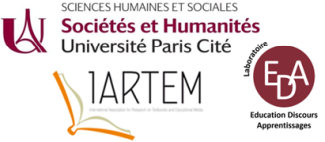Learning with textbooks faced many challenges during the coronavirus disease pandemic, such as low usage due to competition with a wide variety of online teaching materials (Silva & Sousa, 2020) and a lack of teachers' guidance on students' learning (Yan et al., 2021). The electronic version of textbooks might have become more essential since the pandemic. Therefore, the development of textbooks is expected to consider new approaches in digitalization and changes in user habits and learning perspectives (especially interaction with learning content and multimodal perception of information). However, the quality and effectiveness of this shift need further investigation. We aim to map current textbook development trends to find out to what extent the electronic versions of textbooks bring added value for learning in current face-to-face classrooms compared to printed textbooks. More specifically, we focus on textbook components typical only for the electronic environment and provide innovative presentation of learning content, termed as “content added-value resources”. According to Roy et al. (2022), this category includes hyperlinks, videos, audios, interactive images, and interactive animations. In our adapted analysis framework, we examine these components through three main variables typical for e-textbooks: hypertextuality, multimodality, and interaction (see Roy et al., 2022).
Our analysis of new e-textbooks aims to answer the following research questions:
1) What learning content is presented through the multimodal and hypertextual components of e-textbooks?
2) What learning potential of the multimodal and hypertextual components is offered in e-textbooks?
The analysis is conducted as a pilot study providing an illustrative comparison of the presentation of history content in e-textbooks for Czech primary and lower secondary schools. The selected history subject matter serves as a suitable example of various multimodal and hypertextual representations of learning content. It also enables a comparison across the entire compulsory education, as it is taught at both school levels. The sample consists of all multimodal and hypertextual components of approximately 15 e-textbooks that meet the following selection criteria:
a) recently published e-textbooks (year of publication since 2020)
b) e-textbooks including multimodal and/or hypertextual components
c) e-textbooks available for Czech primary and lower secondary school levels
d) e-textbooks from different publishing houses.
The quantitative and qualitative content analysis of students' books and teachers' books is conducted with respect to the research questions, based on the criteria which will be categorized through an inductive coding procedure:
a) Type of hypertextuality (internal, external – Roy et al., 2022)
b) Type of multimodality (videos, animations, etc.)
c) Learning content (topic, context of the unit)
d) Task design, interaction with students (types of learning tasks for students – Siegel & Hensch, 2021)
e) Cognitive structuring of the learning tasks (cognitive load, gradation, differentiation, scaffolding – Fey & Neumann, 2013)
f) Instructional use and adaptation (methodical guidance for teachers on the use of the multimodal and hypertextual components, teaching aims, and competence focus – Siegel & Hensch, 2021).
The results will provide a quantitative summary of the frequency of the observed categories of multimodal and hypertextual components and a qualitative view based on selected examples from different e-textbooks. Preliminary results indicate that although various types of hypertexts and multimedia are present in e-textbooks, explicit guidance on their use is very limited. Further results will bring insights for reflecting on the pedagogical potential of e-textbooks focusing on the context of face-to-face teaching and stimulate discussion.
References:
Fey, C. C. & Neumann, D. (2013). Bildungsmediem Online – Kostenlos angebotene Lehrmittel asu dem Internet. In E. Matthes, S. Schütze, & W. Wiater (eds.), Digitale Bildugsmedien im Unterricht (pp. 55–73). Bad Heilbrunn: Verlag Julius Klinkhardt.
Roy, N., Boyer, P., Lebrun, M., & Samson, G. (2022). Descriptive Analysis of the E-Textbook Situation in Quebec. Formation et profession, 30(2), 1–17.
Siegel, S. T. & Hensch, I. (2021). Qualitätskriterien für Lehrvideos aus multidisziplinärer Perspektive: Ein systematisches Review. In E. Matthes, S. T. Siegel, & T. Heiland (2021), Lehrvideos – das Bildungsmedium der Zukunft? (pp. 254–266). Bad Heilbrunn: Verlag Julius Klinkhardt.
Silva, O. D. L. D., & Sousa, Á. (2020). Perception of Teachers and Students about Teaching and Learning in the Period of Covid-19 Pandemic. In 13th International Conference of Education, Research and Innovation (ICERI2020) (pp. 4832–4838). IATED Academy.
Yan, L., Whitelock‐Wainwright, A., Guan, Q., Wen, G., Gašević, D., & Chen, G. (2021). Students' Experience of Online Learning During the COVID‐19 Pandemic: A Province‐wide Survey Study. British Journal of Educational Technology, 52(5), 2038–2057.

 PDF version
PDF version
